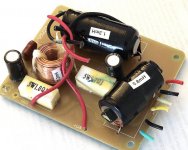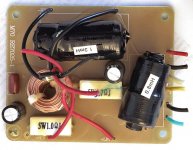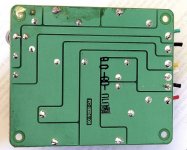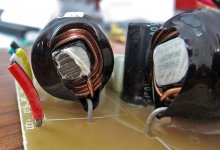the sound was very boomy and the treble was not sharp and clear. previous spkrs I've had in that space are maggie mmg, mission 700, tannoy pbm8. I consider all those mid-fi spkrs and the polk sounded like a HTIB style spkr compared to them.
the crossover is electrolytic based and quite low-end, I admit.
I did try running 2 bass drivers (stock ones, on the bottom) in series and just that, alone. I used the dcx crossover and tried a few cutoffs and curves. amp was a chip-amp (3886).
even the 2 drivers in midbass sounded like junk. not flat, boomy and could not carry much power without distorting.
I could be wrong - but I think the $500/pair price is a laughable joke and the true price IS the sale price. also the fact that these are ONLY available at newegg kind of makes me think this is a walmart syndrome where parts are cheaped-down as a vendor special. that or m70 was always junk and you'd be nuts to pay non-sale prices for them.
I'd be happy to send drivers *that mattered* to someone to measure but I honestly don't think these are worth it. I'm having 2nd thoughts about the cabinet, too. uneven glue on the braces and the front mdf may not take heavier drivers, in fact.
I'm very divided on whether to try to make a silk purse out of this or just start fresh with a real cabinet and not try to retrofit good drives in a junk frame.
the crossover is electrolytic based and quite low-end, I admit.
I did try running 2 bass drivers (stock ones, on the bottom) in series and just that, alone. I used the dcx crossover and tried a few cutoffs and curves. amp was a chip-amp (3886).
even the 2 drivers in midbass sounded like junk. not flat, boomy and could not carry much power without distorting.
I could be wrong - but I think the $500/pair price is a laughable joke and the true price IS the sale price. also the fact that these are ONLY available at newegg kind of makes me think this is a walmart syndrome where parts are cheaped-down as a vendor special. that or m70 was always junk and you'd be nuts to pay non-sale prices for them.
I'd be happy to send drivers *that mattered* to someone to measure but I honestly don't think these are worth it. I'm having 2nd thoughts about the cabinet, too. uneven glue on the braces and the front mdf may not take heavier drivers, in fact.
I'm very divided on whether to try to make a silk purse out of this or just start fresh with a real cabinet and not try to retrofit good drives in a junk frame.
chip-amp (3886).
I'm having 2nd thoughts about the cabinet, too. uneven glue on the braces and the front mdf may not take heavier drivers, in fact.
I'm very divided on whether to try to make a silk purse out of this or just start fresh with a real cabinet and not try to retrofit good drives in a junk frame.
This is THE decision, if it helps I have usually found it better to start from scratch ( but not always ) the cabinet does look thin and flimsy tho this could be helped with T-nuts.
I just looked at the tweeter photo again, what was the cap value in front of it??
Boomy can be fixed, usually stuffing helps or sealing the box, thin midrange or audible midrange distortion is much more difficult
I'll shoot a photo of the crossover. its all on one board.
it was upsetting to see a china-syndrome cap (bursting top seam) on one of the electrolytics. at the very least, the XO would need replacing - but the tweeter really looks like its 'there for show' and not much more. I'll take better photos of it, too (the ones I posted were very poor handheld snaps and I can take much better shots, believe me).
it was upsetting to see a china-syndrome cap (bursting top seam) on one of the electrolytics. at the very least, the XO would need replacing - but the tweeter really looks like its 'there for show' and not much more. I'll take better photos of it, too (the ones I posted were very poor handheld snaps and I can take much better shots, believe me).
I bought a girl-friend a pair of cheap bookshelf speakers at a chain store here ( Dick Smith ) and the tweeter you have looks exactly like the generic high-range driver in the little 2-ways. those had a 2.2 electrolytic cap in line and no shaping at all on the woofer.
bass and mid was actually not at all bad for the price but the tweeter was a piece of C**P, after I changed the XO and put in a second hand Jamo silk dome they were surprisingly good.
Lent them to a niece 3 years ago and she has no plans to upgrade or replace.
So your boxes may have potential, don't junk them just yet. just fixing the components in the XO and swapping in a decent small tweeter may make them OK for a while.
photos of XO will help
bass and mid was actually not at all bad for the price but the tweeter was a piece of C**P, after I changed the XO and put in a second hand Jamo silk dome they were surprisingly good.
Lent them to a niece 3 years ago and she has no plans to upgrade or replace.
So your boxes may have potential, don't junk them just yet. just fixing the components in the XO and swapping in a decent small tweeter may make them OK for a while.
photos of XO will help
As bad as this sounds I would put these back together, and try to sell them for something reasonable to someone via Craigslist.. The cabinets and drivers represent a significant investment on your part, but even the cabinet does not sound worth the trouble.
You can buy a nice kit complete with cabinets that stands some chance of going in the direction you want to pursue.
We all make purchases we regret, and we learn from the experience. Mine was a $440 custom designed acrylic plinth. My solution was to buy a TD-124 instead.. And I gave that plinth to friend for his TT project - he has the particular skills I lack to make it work.
You can buy a nice kit complete with cabinets that stands some chance of going in the direction you want to pursue.
We all make purchases we regret, and we learn from the experience. Mine was a $440 custom designed acrylic plinth. My solution was to buy a TD-124 instead.. And I gave that plinth to friend for his TT project - he has the particular skills I lack to make it work.
Last edited:
kevin, I don't disagree.
I am leaning slightly toward just packing them up and starting fresh, maybe with a zaph audio kit or something that is known to work.
was kind of hoping someone would say 'hey, yeah, I did a mod to that speaker model once and I used ...'. no one said that and maybe I'll be here waiting a long time for it
a friend was over today and we discussed if its worth using this cabinet or not. he also felt it might not be worth it.
still considering all the options...
I am leaning slightly toward just packing them up and starting fresh, maybe with a zaph audio kit or something that is known to work.
was kind of hoping someone would say 'hey, yeah, I did a mod to that speaker model once and I used ...'. no one said that and maybe I'll be here waiting a long time for it
a friend was over today and we discussed if its worth using this cabinet or not. he also felt it might not be worth it.
still considering all the options...
photos of the passive crossover that comes with the m70:
polk monitor 70 crossover | Flickr - Photo Sharing!
polk monitor 70 crossover | Flickr - Photo Sharing!
polk monitor 70 crossover | Flickr - Photo Sharing!
color codes: on the photo from the top view, the red/black on top is "ud1+, ud2-"). I assume that means 'upper driver' (group).
next down is white/yellow: ld2-, ld1+
finally, last pair is black, green: T-, T+ (tweeter, obviously).
for values, the brown poly (?) cap to the left below the m70 label is "224j" and so I take that to mean .22uF.
the center electro is 10uF 50v.
the electro far off in the corner is 8uF 50v.
the aircore inductor is 0.2mH.
I think the rest of the parts are easy to see the label on.
HTH a little.
polk monitor 70 crossover | Flickr - Photo Sharing!
polk monitor 70 crossover | Flickr - Photo Sharing!
polk monitor 70 crossover | Flickr - Photo Sharing!
color codes: on the photo from the top view, the red/black on top is "ud1+, ud2-"). I assume that means 'upper driver' (group).
next down is white/yellow: ld2-, ld1+
finally, last pair is black, green: T-, T+ (tweeter, obviously).
for values, the brown poly (?) cap to the left below the m70 label is "224j" and so I take that to mean .22uF.
the center electro is 10uF 50v.
the electro far off in the corner is 8uF 50v.
the aircore inductor is 0.2mH.
I think the rest of the parts are easy to see the label on.
HTH a little.
Attachments
Last edited:
I'm now about 80/20 toward putting them back together and selling them locally.
the more I see the insides, the less I like. I need to shoot some photos of the inside bracing. its sloppy and there are gaps along edges where they 'hoped' the glue would fill but its just a lot of emptyness..
I like the outside fake veneer though. does that count?? (I'm kidding, mostly).
there is a roll of fiberfill that separates the lower and upper regions. it looks like a barrier but it is just fiberfill in a roll and doesn't that mean the whole cabinet is now acoustically 'all the same' and that there isn't really a lower and an upper region? should there be? I know, I need to shoot a pic of that, too, to show what I mean.
btw, thanks for the XO links. mostly stuff I already knew - but its the spkr building and cabinetry that I'm mostly weak on. and again, I'm not using passive XO in my final config since I'm going electronic, remember?
the more I see the insides, the less I like. I need to shoot some photos of the inside bracing. its sloppy and there are gaps along edges where they 'hoped' the glue would fill but its just a lot of emptyness..
I like the outside fake veneer though. does that count?? (I'm kidding, mostly).
there is a roll of fiberfill that separates the lower and upper regions. it looks like a barrier but it is just fiberfill in a roll and doesn't that mean the whole cabinet is now acoustically 'all the same' and that there isn't really a lower and an upper region? should there be? I know, I need to shoot a pic of that, too, to show what I mean.
btw, thanks for the XO links. mostly stuff I already knew - but its the spkr building and cabinetry that I'm mostly weak on. and again, I'm not using passive XO in my final config since I'm going electronic, remember?
Yes, i only threw those in so you could have a rough idea of where the XO points in those boxes were.
I prefer electronic XO for bass and mid-bass but sometimes a passive XO is cheaper ( and some argue better ) at the mid-tweeter frequency.
My basic rule of thumb is to try and get the mid-range driver to cross over as low as possible, as I use those cheap Behringer CX units that is easy and I usually cross at around 120 // 250 Hz
I am beginning to believe that only a 4-way system can deliver what I want.
just in case you didn't know ~ 375 Hz is the midpoint for music energy, half below that half above
I prefer electronic XO for bass and mid-bass but sometimes a passive XO is cheaper ( and some argue better ) at the mid-tweeter frequency.
My basic rule of thumb is to try and get the mid-range driver to cross over as low as possible, as I use those cheap Behringer CX units that is easy and I usually cross at around 120 // 250 Hz
I am beginning to believe that only a 4-way system can deliver what I want.
just in case you didn't know ~ 375 Hz is the midpoint for music energy, half below that half above
getting fancy, it might be nice to have a switchable passive/active config. if you are watching tv or doing non-critical things (lol) then there's no real need to fire up 2 extra amps. less heat and less money wasted on power. but then when you want to hear music, you enable active-mode and turn on 2 extra amps (and do the wire routing to match). it would mean using spkr-level relays and being able to defeat the active crossover (not too hard by remote control) but I like the flex of being 'both'.
maybe no one thinks like that (lol) but I'd like to be able to choose based on the application at the time. might be a neat side project, in fact.
a friend of mine on my flickr photo site noticed that the iron core chokes are stacked metal layers but that they are not enameled or glued or doped together. they are simply just taped and then shrink wrapped. I was concerned that these might make noise in operation. any opinions?
here's the close-up:
maybe no one thinks like that (lol) but I'd like to be able to choose based on the application at the time. might be a neat side project, in fact.
a friend of mine on my flickr photo site noticed that the iron core chokes are stacked metal layers but that they are not enameled or glued or doped together. they are simply just taped and then shrink wrapped. I was concerned that these might make noise in operation. any opinions?
here's the close-up:
Attachments
KLBird
Most of the on line reviews of these speakers are positive. Certainly not a high end speaker but adequate for a mass produced speaker. I suggest you try and sell them as is, rather than try any mods which may not work for you and destroy any chance of recovering any part of your investment.
due to a holiday impulse buy (lol) I have a pair of polk monitor 70's.
I tried them and didn't like the sound but thought that maybe the cabinets are salvagable and with some driver replacements and active crossover (maybe eq) it could be passible.
is this is a fool's errand? tell me now that there's no way to make this into at least a mid-fi system and I'll stop and just sell them as used.
but I'd like to give it at least a chance. this is a tower config with 4 6" holes and one 'mtm' tweeter hole toward the top. there's also a port at the bottom/front. I currently do have an active crossover (dcx2496) and am building some chip-amps for the various driver channels. I don't really see the need for a passive crossover and that gives me a lot of freedom in picking drivers (no?)
the as-shipped config seems to be the bottom 2 6" drivers in series and being a bass or midbass system. there is a roll of padding between the lower 2 and the upper region (the mtm area). maybe I can have 1 *good* aftermarket driver in the lower area and have a 6" round mdf disc made to cover the other hole. that wouldd be a lowpass section.
on top the tweeter hole is non-standard and so its a loss for all but the smaller surface-mount style tweeters. maybe I ignore the factory tweeter hole, cover it up and put the new tweeter up in the top woofer hole, with a suitable mdf bezel plate made for it.
finally a midrange could fit in the remaining 6" hole. any size driver less than or = 6" would fit with another mdf bezel.
I took some shots of the drivers that come shipped with this speaker system. I'm not sure they are even worth using. the question is: is the cabinet worth using; or is it too backward to try to find drivers to fit just a 'chassis' instead of the other way around?
Most of the on line reviews of these speakers are positive. Certainly not a high end speaker but adequate for a mass produced speaker. I suggest you try and sell them as is, rather than try any mods which may not work for you and destroy any chance of recovering any part of your investment.
<snip>
a friend of mine on my flickr photo site noticed that the iron core chokes are stacked metal layers but that they are not enameled or glued or doped together. they are simply just taped and then shrink wrapped. I was concerned that these might make noise in operation. any opinions?
here's the close-up:
I'd be more concerned about their poor linearity than any noise they make..
I never did a thing with them. sad to say, they sit, unused, in my garage, in storage. (anyone want them, cheap? I'm happy to sell below cost just to get them out of my garage) 
I built some kit spkrs from madisound (the seas L18 metal woof/tweet pair) and those are quite good for their price and I'm very satisfied with them. they are not big spkrs, but they sound so clean and clear; something I'd probably never get form the drivers and cabinet of the polk.
these are 'great' for teens who are just getting into music, I think. but not really modify-material for audiophiles. just did not seem to be worth all the effort to reinforce the cabinet and replace the drivers and have to 'make things work' somehow. no matter what I would do, it would be a hack, with this cabinet and predrilled holes that don't match anything I would want to use.
I built some kit spkrs from madisound (the seas L18 metal woof/tweet pair) and those are quite good for their price and I'm very satisfied with them. they are not big spkrs, but they sound so clean and clear; something I'd probably never get form the drivers and cabinet of the polk.
these are 'great' for teens who are just getting into music, I think. but not really modify-material for audiophiles. just did not seem to be worth all the effort to reinforce the cabinet and replace the drivers and have to 'make things work' somehow. no matter what I would do, it would be a hack, with this cabinet and predrilled holes that don't match anything I would want to use.
IF you have a DXC, then literally anything can be adjusted to sound at least good. Set your DCX up for 3-way stereo. Power the two lower woofers as the low pass, say 30 - 500Hz. The top two as mid pass with full lower bandwidth, say 30 - 2k, and the tweeter as high pass, say 2k to 20k. Power response is more important than front response and the crossover frequencies need to match at 30 degrees to each side. To initially set levels, time delay the tweeters to match the mids at your chosen listening height. Set the mid band pass to 5k and the high low pass to 1k, stand 30 degrees off to the side. Toggle the mid and high on and off and adjust levels so a pure 2k tone is at matching volume between the mid and high sections. Then back your mids down to the 2k cuttoff and highs to the 2k cuttoff. Listening straight on, weep a sine wave between 1k and 5k and adjust the crossover frequencies so the volume is even and smooth as it moves between the mid and high drivers. Use the eq to notch out any weirdness that remains. You now have a two way mtm that should sound decent as far as on-axis response and power response. Finally, bring in the lower two drivers, listening from your chosen listening position. Adjust their level and high pass to blend smoothly with he top two drivers and fill in the bottom 4 octaves. Adjust high-pass and eq as necessary to make sure that lower mids are smooth and not boomy. EQ bottom octaves to taste. If you have something to measure frequency response and impulse response you can dial the settings in a bit tighter but if you have a good ear and with some practice you can get VERY close to something that would cost thousands of dollars off the shelf. AND, keep in mind that multi-thousand dollar speakers often use the same junky drivers that you have, all the work is in the crossover.
- Status
- This old topic is closed. If you want to reopen this topic, contact a moderator using the "Report Post" button.
- Home
- Loudspeakers
- Multi-Way
- polk monitor 70: worth any kind of upgrade or not?



